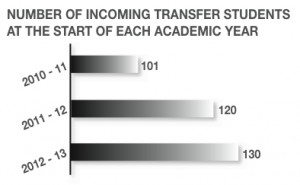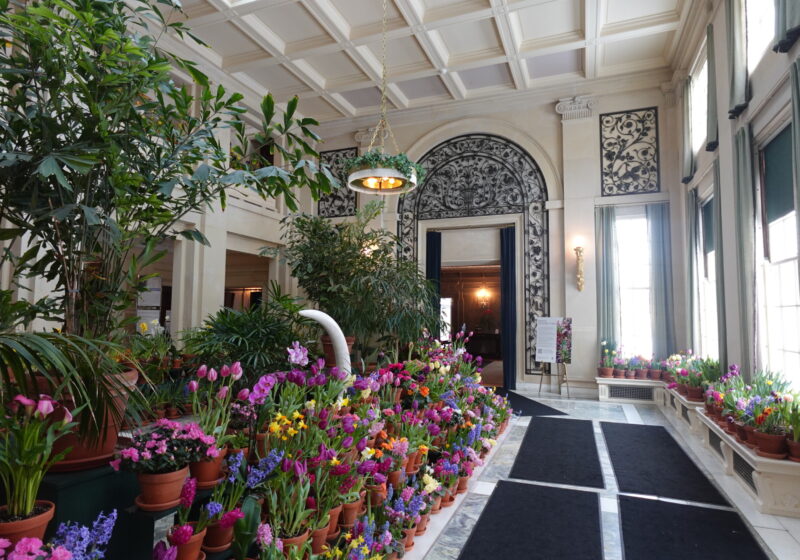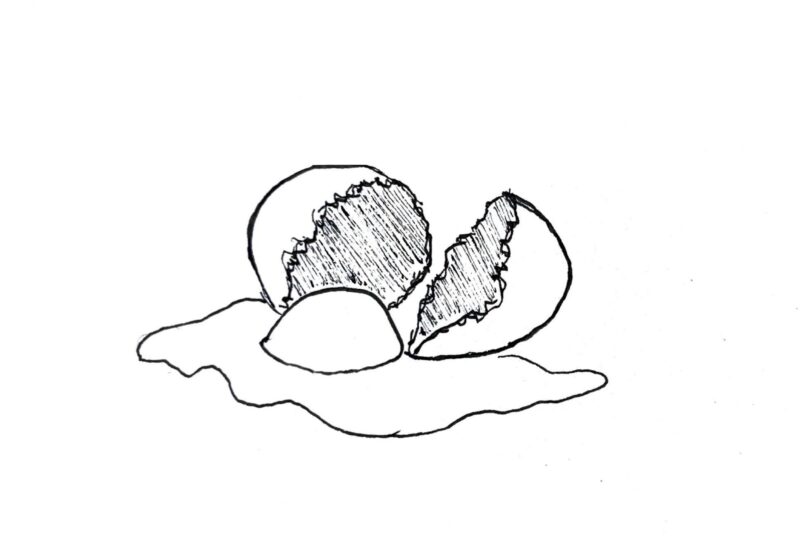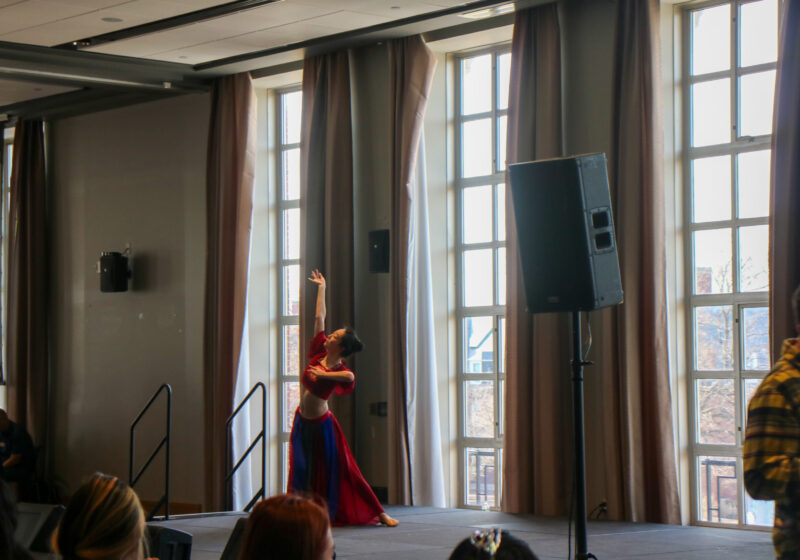
Julia Sklar, Presentation Editor
There is a modest, white-paneled house that sits in a leaf-strewn West Irondequoit suburb. Steep stone steps lead up to the front door and a post mount mailbox rests amid the grass on the front lawn. A man answers the door with a curious child close on his heels.
“Are you here for Anna?” he asks.
Welcome to the home of sophomore Anna Price—a wife, a mother of three young children and yes, an undergraduate student at UR.
Price, who is 35 years old, graduated from Brighton High School when she was 18 and enrolled at Emerson College in Boston on an acting scholarship. A top-notch student in high school, she excelled her first semester, but after the death of a close family friend and an abusive relationship, her performance plummeted in her second semester and she lost her scholarship.
“I was really a mess and my self-esteem was very, very low because of all these things,” she said. “I just felt like I had failed so horribly.”
Price got her second chance when she enrolled at Monroe Community College (MCC) and earned her associates degree, graduating with flying colors. She transferred to UR in August.
“I didn’t want my kids to ask me why I’d never finished college and not really have a good reason for them,” she said.
Price is just one of many non-traditional students at UR. There is no official definition of a non-traditional student, according to Tanya Strachan, assistant director in transfer recruitment and enrollment programs in the Office of Admissions, who works with many non-traditional students, since the term is defined differently by different institutions. She summed up the loaded phrase as students who have taken an atypical path in completing their higher education. Strachan believes that these students bring fresh perspectives to the University.
“I think most non-traditional students have a non-traditional view on the world,” she explained.
UR does not track non-traditional student enrollment specifically, but transfer student enrollment has increased over the past three years.
At the start of the 2010-11 academic year there were 101 incoming transfer students, 120 at the beginning of the 2011-12 academic year and 130 this past August. Strachan attributes this rise to an increase in applications as a whole.
National trends indicate an upswing, too. According to an article in The Atlantic, there are 17.6 million undergraduates enrolled in American colleges and universities, only 15 percent of whom attend four year colleges while living on campus. Thirty-eight percent of enrolled students are over the age of 25 and one-fourth over the age of 30. By 2019, the number of students aged over 25 is expected to increase by 23 percent.
Cue junior Mirlin Moorefield. At 44, he’s certainly no doe-eyed freshman. He’s worked over 40 jobs, from taxi driver to radio announcer, has lived in nearly 20 different places and has a 23-year-old daughter and a four-year-old grandson. He graduated high school at 16 and began at Averett College (now University) in the fall of 1984. Burnt out, he slacked off his first year and dropped out until 2009 when he started at MCC. After transferring to Finger Lakes Community College (FLCC) he enrolled at UR this past August as well. Stocked with an unassuming southern twang, he is candid about his experiences as a non-traditional student.
Although Moorefield is glad to be at UR, he has a number of gripes about how the University treats its non-traditional students.
“[These] types of students, few as they are, are as important as our other students,” he said.
Among the frustrations Moorefield has encountered since arriving at UR have been finding appropriate on-campus housing, having to wait until orientation to register for classes — given that he had to find a job as well in order to support himself — and an orientation lacking in many activities geared toward transfer students.
“I’m not blaming anyone in particular because it’s such an unusual situation, but it got me thinking … there needs to be something here that can help people in my situation — that can give them information,” he said.
Junior Al Karabell, a 21-year-old transfer student from St. Louis Community College-Meramec, a community college in St. Louis, Mo., who was home schooled until he was 16 and entered community college, also had a frustrating experience when he first came to UR.
“Orientation was disgustingly bad,” he said. Although he understands that there are not as many transfer students as incoming freshmen, he still wishes that there had been more events geared toward transfers.
Strachan acknowledges that UR’s integration of non-traditional students is not perfect and that “there would possibly be opportunities for improvement,” but she believes UR is on the right track.
“It’s hard to develop something exactly for everyone, so I think we do a great job at what we do,” she said.
Hence Moorefield’s latest endeavor, which could help benefit students in the same boat as him, Price and Karabell, a club for non-traditional students at UR. He hopes the group will help foster ties between this growing population and the University as well as act as an affinity group for incoming students, many of whom have experienced similar advantages and disadvantages while studying as non-traditional students at UR. The club could also help to create a more accommodating environment for non-traditional students, he explained.
The group is still getting off the ground — although Moorefield has found three volunteers to act as advisers he still needs to find 12 interested students in order for the club to qualify as a candidate for Students’ Association recognition or funding. He hopes that it will eventually establish a permanent presence at UR.
Although she had not yet heard about Moorefield’s group for non-traditional students, Price responded positively to the idea, acknowledging that it would be nice to meet people in the same boat as her, especially other students with children in order to exchange tips on how to balance life as a parent and an undergraduate.
For Moorefield, a huge goal will simply be the ability to provide a welcoming environment for non-traditional students, some of whom find it difficult to connect with the typical undergraduate population.
“I feel awkward most of the time because of my age,” Moorefield explained. “I don’t talk much — when I do talk I think about what I want to say before I say it for fear of sounding like an old idiot.”
Other non-traditional students, like junior David Kelly, who is 52 years old and married with three young children who range in age from four to 10, and enrolled at UR in the fall of 2011, have already found their own niche at the University.
A competitive golfer in years past, Kelly called the Department of Athletics and Recreation when he got accepted to the University, spoke with golf head coach Dan Wesley and ended up coming on as the assistant coach, a position which he says gives him the college experience by way of the other students on the golf team.
“Am I living somewhat vicariously through them?” he said. “Yes, but the fact of the matter is, it’s pretty rewarding being involved on that level.”
It is their experiences though that seem to set non-traditional students apart from the rest of the undergraduate population. Price believes that being an older student works to her advantage.
“I don’t take being in school for granted at all,” she said. “I love it and I consider it to be an enormous privilege. I feel like my level of responsibility and organizational skills are head and shoulders above where they were when I was 18 years old.”
Kelly has a similarly serious attitude toward his education, a mindset that is common among many non-traditional students, especially those that are older than the typical undergraduate.
“From day one I always treated this like a job,” he said. “This is a job to me — it isn’t a hobby, and I’ve gone at it with a vengeance.”
Despite the difficulties that may arise for non-traditional students, it appears that many have a positive outlook about being at UR.
“I feel very blessed to be here,” Price said. “It’s a wonderful university.”
Nobody, though, puts it better than Moorefield.
“I think it’s pretty damn badass I’m here,” he said.
Goldin is a member of
the class of 2013.





